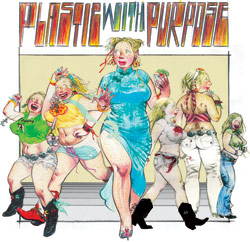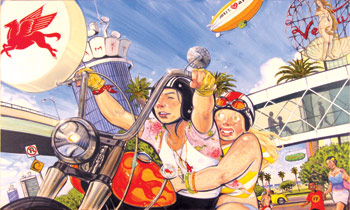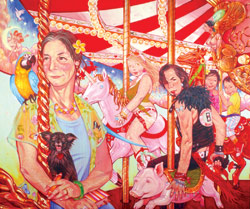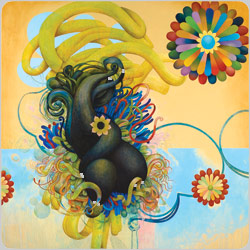At first glance, the world of Taiyo la Paix's paintings is a bubble gum dream of carnival rides, palm trees and beautiful people in rock-star clothing. In fact, la Paix has been criticized for overindulging the fluffy fantasy.

"I actually think about heavy issues a lot, both on a global and personal scale," he says. "My response comes out like this: There's no meanness in my painting, but always sadness."
The melancholy is hidden between the lines, in memento mori — a dark passion of la Paix, whose bright hues contain somber reminders that life is precious and fleeting. A skeleton emblem on a speeding motorcycle, an hourglass on the back of a leather jacket and always butterflies, their life spans but a couple of weeks.
At the center of la Paix's oil-and-canvas universe is Papillia, a buxom blond in Daisy Dukes, midriff-revealing tops and an enviable collection of cowgirl boots. Papillia would be a pinup projection of male desire, except that her expressions are so over-the-top emotive that she comes off as a bit of a lovable goof.
"I didn't want the standard Hollywood beauty that everyone could appreciate," la Paix says of his Rubenesque heroine. "What matters to me most is personality."

There's more to the story than one artist's study of the feminine form. Though la Paix (born in Japan and educated in the U.S.) studied art through college, his career was waylaid by a family illness that saw him spending his 20s as a round-the-clock caregiver. During his darkest hours, unable to pursue art or connect with friends, la Paix created an elaborate fantasy — a sort of parallel world in which he could really live. His partner in crime — in motorcycle rides, street fairs, carousels and sudden summer storms — was Papillia, a creature both sexy and nurturing, desirable and visceral. When la Paix's situation suddenly changed and he was free again to paint, his first projects included portraits of his own muscled and fearless doppelganger, and of curvy Papillia surrounded by butterflies.
The continuum of Papillia and la Paix (who's real-life partner resembles — albeit toned-down, fashion-wise — the fictional girlfriend), spans dozens of canvases and sketches and explores not just a rosier-than-reality relationship, but also a romance with commercialism.

Take "Mother Sky," a 3-foot-by-12-foot painting completed for the upcoming Fall Salon exhibit at Blue Spiral 1. In the picture, la Paix and Papillia ride a motorcycle (complete with stylish-if-foolhardy monkey bars) under a Mobile Oil pegasus sign. "People will think of corporate greed, but I'm not taking sides, I'm just starting a debate," the artist says. "I like the idea of taking corporate symbols and cliches that suggest a better future — we've all gotten very cynical about slogans — and reinterpreting them in a naive, straightforward way." After all, the winged steed is every bit as much a nod to flight and freedom as is the live-free-or-die lure of bike culture.
For la Paix, who was inspired by Japanese pop-culture media like anime (animation) and manga (cartoons), commercialism doesn't automatically equal bad. "All the energy is in commercial art," he says. "The talent going into commercial art is phenomenal, but how we feel about commercial art versus art-for-art's-sake is very telling about how we feel about consumerism."
Figure study
by A.M.
Daniel Nevins removed the human forms from his paintings
Local artist Daniel Nevins, who will also show in the fall exhibit at Blue Spiral 1, has an instantly identifiable style. Centered around graceful, folkloric figures, the paintings call to mind Russian iconography, Mercer Mayer illustrations, age-old fables and New Age-y inspirational themes. It's that melding of meditation and color, ancient and modern, magical and mathematical that makes Nevin's dreamy canvases so desirable. (He's been represented by Blue Spiral for more than a dozen years, and his shows often sell out.)
But fans of Nevins' work are in for a surprise: The artist's latest endeavor is a departure from form. Yes, the earthy-ethereal palate is still present, as are Nevins' geometrically precise flowers and tendrils. But what's conspicuously absent are the figures. Instead of human forms and story lines, the paintings reveal organic forms, amorphous abstractions and tangled grips of color on the brink of either evolution or decay.
Nevins' new body of work will be on exhibit as part of the Fall Salon at Blue Spiral 1, through Thursday, Dec. 31.

That subject, too, is broached in la Paix's work. The plastic baubles his subjects love? Those are both frivolous decoration and allusions to deeper meaning. Papillia wears a goldfish charm that represents the beloved pet of la Paix's real-life partner. In "Elizabeth (Ma Between Brain Surgeries)," Papillia rides a My Little Pony-like unicorn, it's plastic-y horn (said to neutralize poison) intentionally pointed at the head of la Paix's mother, who did indeed endure multiple operations.
"We can believe in something grand and great," says la Paix. In his own version of making lemonade from life's sour fruits, when the real world is less than pretty, la Paix paints himself a happier version.
who: Taiyo la Paix (www.taiyolapaix.com)
what: Fall Salon show
where: Blue Spiral 1 (www.bluespiral1.com)
when: Opening reception is Thursday, Oct. 1 (5-8 p.m. 251-0202. Exhibit runs through Thursday, Dec. 31)



Crumb meets Anime. At first glance I was intrigued, but on further inspection I felt like I had seen it all before.
“. . .the paintings call to mind Russian iconography, Mercer Myers illustrations . . .”
Could the writer mean the well-known children’s book author and illustrator Mercer Mayer?
Mercer Mayer: Exactly. Good catch!
Joel,
Look again,I knowyou must be missing the depth and the pathos of these works. Not only is the work amazingly well crafted, but the imagery and iconography are multi-level and very careful. Further, there ain’t much Crumb here – this is much more caring.